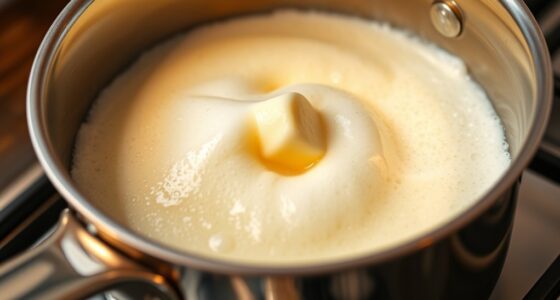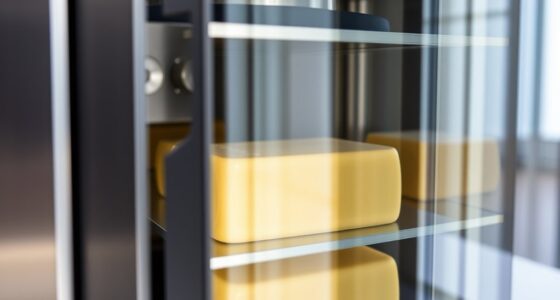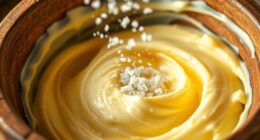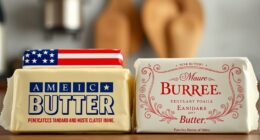To create safe, edible butter shapes with 3D printing, choose food-grade filaments like PLA or PETG that are certified for consumption. Make certain your printer is clean, calibrated, and compatible with these materials. Focus on simple, stable designs to avoid mishaps and incorporate food-safe coatings for added appeal and freshness. Proper storage, handling, and maintenance are key to quality results. Keep exploring; you’ll discover more tips on refining your edible butter art.
Key Takeaways
- Use only food-grade, certified filaments like PLA or PETG that are approved for consumption.
- Ensure proper printer calibration, cleaning, and temperature settings to prevent contamination and ensure safety.
- Design simple, stable butter molds with smooth surfaces and flat bases for easy printing and removal.
- Apply food-safe, transparent edible coatings to enhance appearance, flavor, and shelf life of the butter shapes.
- Store finished shapes in airtight, refrigerated containers away from odors, handling gently to prevent damage.
Understanding Food-Safe Filaments for Edible Printing

Have you wondered what makes a filament safe for edible 3D printing? The key is ensuring it’s food-grade, free from harmful chemicals, and approved for consumption. Food-safe filaments often incorporate dairy ingredients, which can improve texture and flavor, making the final product more appealing. These dairy-based components also serve as natural flavor enhancers, elevating the overall taste of your butter shapes. When choosing a filament, check for certifications and manufacturer transparency about ingredients. Using food-safe materials minimizes health risks, ensuring your creative butter designs are safe to eat. Remember, the right filament not only guarantees safety but also enhances flavor, making your edible creations both beautiful and delicious.
Top Materials Suitable for Butter Shaping Projects
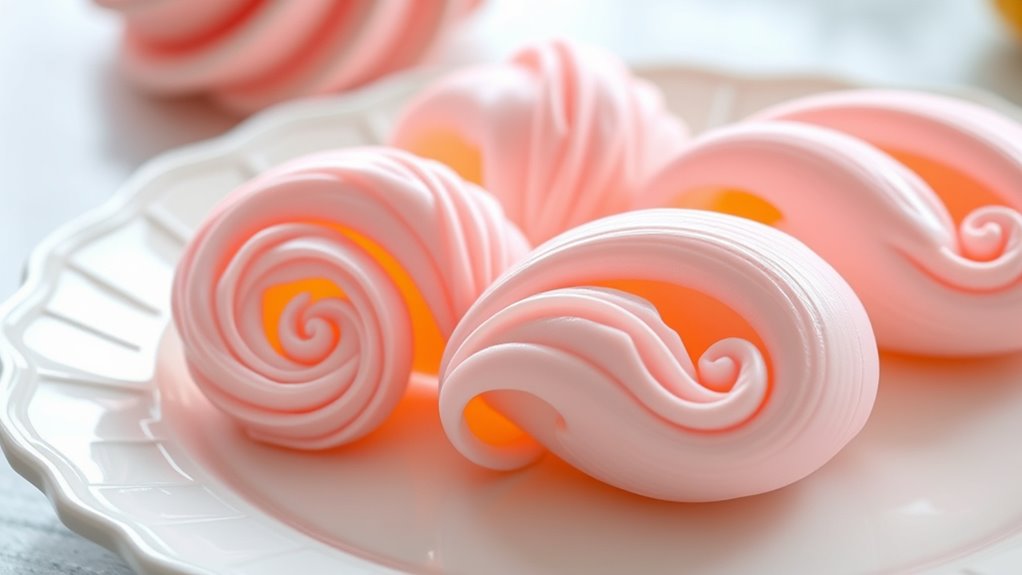
When choosing materials for butter shaping, you’ll want food-safe filaments that won’t compromise taste or safety. Consider the compatibility of the filament with your 3D printer to guarantee smooth printing results. Paying attention to these factors helps you select the best materials for your edible creations. Additionally, selecting Gold IRA rollovers can provide a secure and diversified investment strategy for long-term financial stability.
Food-Safe Filament Options
Choosing the right filament is essential for guaranteeing your 3D printed butter shapes are safe to use with food. Food-safe filaments like PLA and PETG are popular choices because they have a neutral dairy flavor and a suitable melting point, preventing deformation during handling. PLA is biodegradable, easy to print, and generally regarded as food-safe when using food-grade filament. PETG offers higher temperature resistance and durability, making it ideal for butter shapes that may come into contact with warmth. Both materials have melting points that minimize the risk of warping or melting when in contact with butter at room temperature. Selecting a filament specifically labeled as food-safe ensures your project remains safe, hygienic, and free from harmful chemicals. Food contact safety is an important consideration in choosing materials for edible applications.
Material Compatibility Tips
To guarantee your butter shaping projects turn out safely and effectively, selecting the right materials is essential. Ensure your filament has a food grade certification to guarantee safety and compliance with health standards. Compatibility with butter is key; some plastics may degrade or release unwanted substances. When choosing filaments, consider these tips:
- Opt for food-safe, certified filaments designed for edible applications.
- Use filament color options that help differentiate between different projects or flavors.
- Verify that the filament’s temperature resistance matches your printer’s settings to prevent melting or warping.
Additionally, always check for material compatibility to prevent potential chemical reactions with butter.
Preparing Your 3D Printer for Edible Filaments
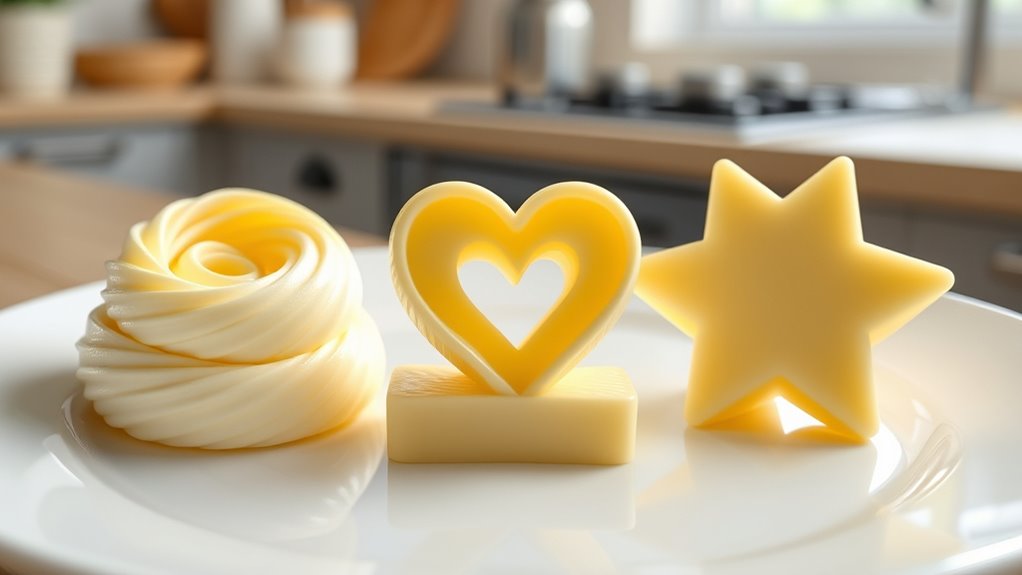
Before you start printing with edible filaments, it’s essential to prepare your 3D printer properly. Begin by thoroughly cleaning your print bed and extruder to prevent contamination, ensuring food safety. Check that all components are compatible with food-safe materials, considering nutritional considerations and minimizing potential health risks. Adjust the printer’s temperature settings according to the filament manufacturer’s recommendations, which helps maintain print quality and preserves the integrity of the edible material. Use environmentally friendly cleaning supplies to reduce your environmental impact during setup. Calibrate your printer precisely to avoid waste and ensure consistent results. By taking these steps, you create a safe, efficient environment for printing butter shapes, respecting both nutritional and ecological concerns.
Designing Butter Shapes for Optimal Printing Results

Designing butter shapes that print successfully requires careful consideration of their geometry and surface features. You should focus on simple, stable designs that minimize overhangs and complex details, which can cause printing issues. Proper mold design is essential to ensure smooth removal and consistent results. Incorporate features like flat bases or rounded edges to improve adhesion and reduce warping. When planning your butter sculpting projects, keep these points in mind:
Choose simple, stable butter shapes with smooth surfaces and easy mold removal for successful sculpting.
- Use clean, smooth surfaces to prevent filament sticking or imperfections
- Avoid intricate details that may not print well in soft butter
- Design for easy mold removal without damaging the shape
Tips for Ensuring Food Safety During the Printing Process
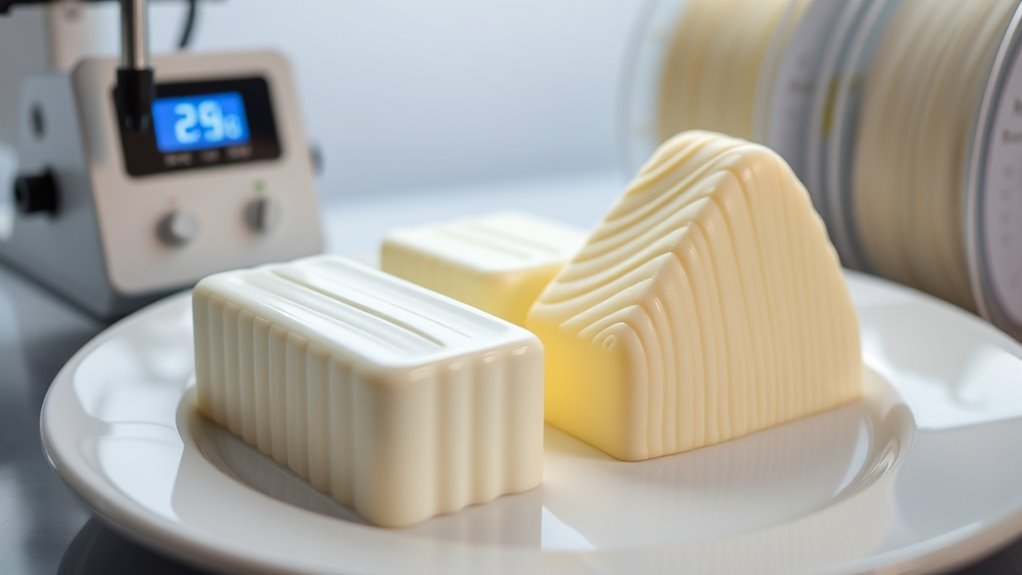
Ensuring food safety during the 3D printing of butter shapes is essential to prevent contamination and guarantee the final product is safe to eat. Start with clean equipment and use food-safe filaments designed specifically for edible applications. Pay attention to nutritional considerations by choosing filaments that align with dietary needs and avoid cross-contamination. Implement strict allergen management by thoroughly cleaning tools and avoiding contact with common allergens if sensitive individuals will consume the product. Always handle ingredients with gloves and sanitize surfaces regularly. Keep the printing environment hygienic to minimize risks. Double-check that your filament packaging is sealed and labeled for food use. Additionally, understanding the different types of dog names can help you select a fitting and charming name for your new pet. These practices help guarantee your butter shapes are safe, nutritious, and free from unwanted contaminants.
Post-Processing Techniques for Edible 3D Prints
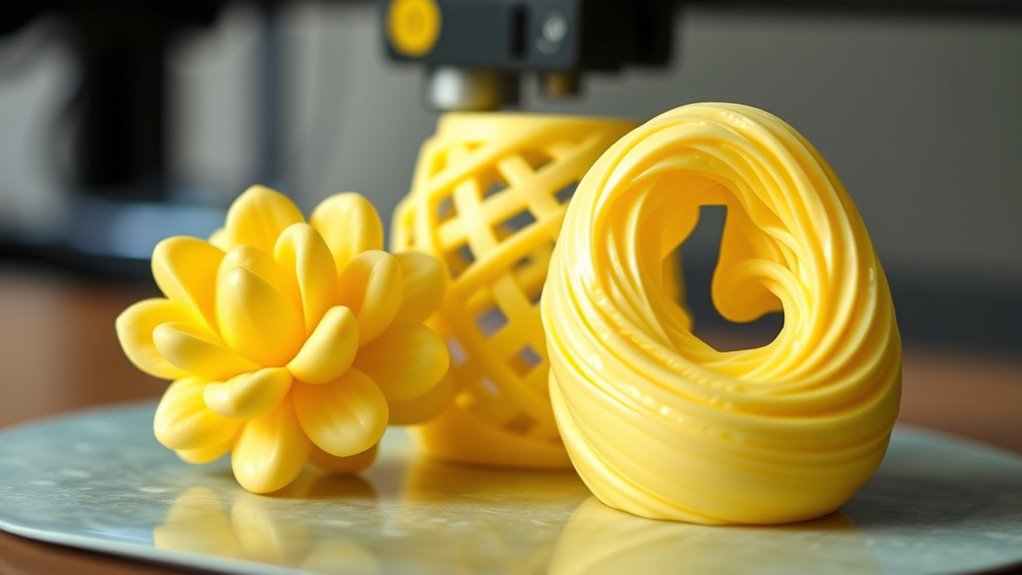
After printing your butter shapes, it’s important to properly clean and sanitize them to guarantee food safety. You can also enhance their appearance and durability by applying edible coatings. Finally, store your creations correctly to keep them fresh and maintain their quality.
Cleaning and Sanitizing Prints
Cleaning and sanitizing your 3D printed butter shapes is essential to guarantee they’re safe to enjoy. Proper cleaning removes surface residues that could cause ink transfer or harbor bacteria. Use warm water and mild soap to gently scrub the surface, avoiding abrasive materials that might damage filament durability. Be cautious with cleaning agents, as harsh chemicals can weaken the filament or affect food safety. To make certain of thorough sanitization:
- Rinse thoroughly to remove soap residue
- Use a food-safe disinfectant if needed
- Dry completely before storage
- Ensure color accuracy through calibration to prevent discoloration or staining.
Edible Coating Techniques
Applying an edible coating to your 3D printed butter shapes enhances their flavor, appearance, and shelf life. An edible coating acts as a barrier, protecting the shape from moisture and oxidation while also allowing you to infuse additional flavors. To apply, lightly brush or spray the coating evenly over the surface, ensuring complete coverage without excess. For flavor infusion, incorporate herbs, spices, or natural extracts into the coating before application. This process not only boosts taste but also creates an attractive finish. Use food-safe, thin, and transparent coatings to preserve the visual appeal of your butter shapes. Proper application ensures a uniform layer that improves both the sensory and aesthetic qualities, making your edible 3D prints more appealing and flavorful.
Proper Storage Methods
To keep your edible 3D printed butter shapes fresh and flavorful, choosing the right storage method is essential. Proper storage extends shelf life and maintains quality. Keep your shapes in an airtight container or wrap them tightly to prevent exposure to air and moisture. Refrigeration tips include storing at consistent temperatures and avoiding frequent temperature changes, which can cause condensation. For ideal shelf life management, label each batch with the date you made it. Always store butter shapes away from strong-smelling foods to prevent odor absorption. Consider using vacuum-sealed bags for long-term storage, especially if you’re not planning to consume them soon. Prioritize cool, dark places in your fridge and avoid direct sunlight to preserve flavor and texture. Additionally, using self-watering techniques can help maintain optimal moisture levels if storing the shapes for an extended period.
Common Challenges and How to Overcome Them

Creating detailed butter shapes with 3D printing can be tricky, as issues like uneven melting, clogging, and poor adhesion often arise. Texture issues can cause the butter to smear or lose detail, so ensuring consistent temperature and proper filament flow is vital. To overcome adhesion problems, make sure your print bed is clean and properly prepared with a food-safe adhesive or surface. Adjusting print speed and temperature can help improve layer bonding, reducing the risk of warping or detachment. If you experience clogging, check for blockages in the nozzle and use high-quality, food-safe filament suited for butter. Regular maintenance and calibration are essential to prevent these common challenges, ensuring smoother prints and more precise butter shapes every time. Additionally, understanding 3D printing safety guidelines is crucial when working with food-safe materials to maintain a hygienic process.
Creative Ideas for Butter Shape Designs

Unleash your creativity by exploring a variety of butter shape designs that add a fun and personalized touch to your dishes. With the right butter mold designs, you can craft decorative butter art that impresses guests and enhances presentation. Think beyond traditional shapes—try floral motifs, intricate animals, or themed holiday designs to make your butter stand out. Experiment with different textures and details to elevate your creations. Keep in mind that unique designs can set the mood and add a personal touch to any meal. Here are some ideas to spark your imagination:
- Nature-inspired patterns, like leaves or flowers
- Elegant geometric shapes for modern tables
- Fun character or holiday-themed molds
Incorporating innovative automation technologies can also streamline your process and help you create more complex designs with ease. Let your imagination run wild with creative and eye-catching butter shapes!
Maintaining and Storing Edible 3D Prints

Once you’ve crafted your intricate edible 3D prints, proper maintenance and storage become key to preserving their appearance and safety. To prevent color fading, store your butter shapes in an airtight container away from direct sunlight, which can affect dye application. Keep them in a cool, consistent temperature to maintain their texture and prevent melting or deformation. If you’ve added dye application for vibrant colors, handle the prints gently to avoid smudging or chipping. For texture enhancement, avoid stacking or pressing prints against each other, as this can damage delicate details. Wrapping your creations in parchment paper or food-safe plastic wrap helps retain freshness and prevents moisture loss. Regularly check stored prints for signs of spoilage or melting, ensuring they remain visually appealing and safe to consume.
Future Trends in Edible 3D Printing and Butter Art
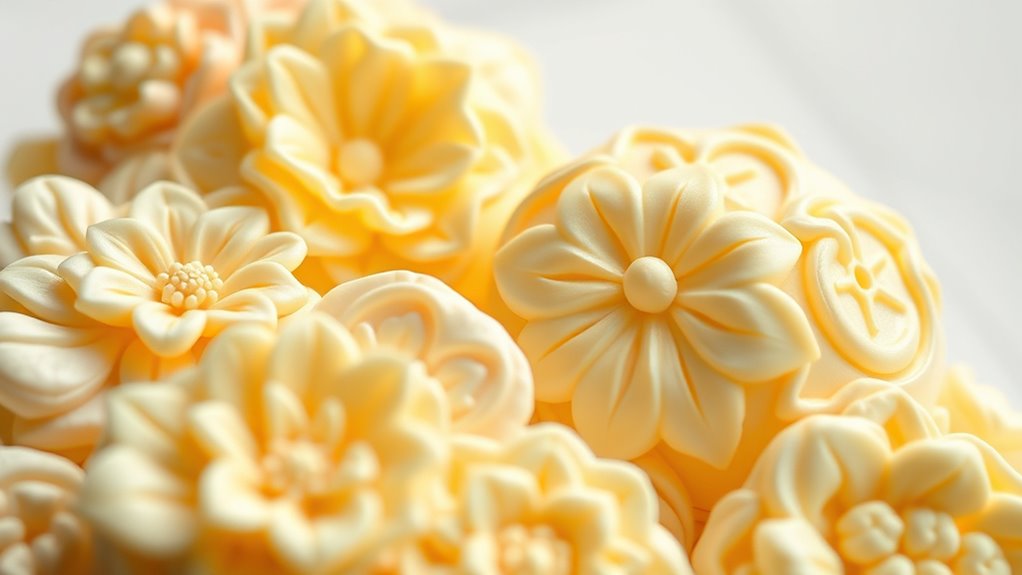
As technology advances, edible 3D printing and butter art are poised to become more innovative and accessible, transforming both home kitchens and professional culinary scenes. Expect sustainable packaging to play a larger role, reducing waste and enhancing eco-friendliness. Future trends will likely include more sophisticated flavor infusion techniques, allowing you to customize tastes directly within your butter shapes. You might also see the development of biodegradable filaments, making the entire process more environmentally conscious.
Key trends include:
- Integration of sustainable packaging options to reduce environmental impact
- Enhanced flavor infusion methods for personalized tastes
- Expanded use of biodegradable, food-safe filaments for eco-friendly creations
These innovations will make butter art more versatile, sustainable, and flavorful, inspiring your culinary creativity to new heights.
Frequently Asked Questions
How Long Do Edible 3d-Printed Butter Shapes Typically Last?
Your edible 3D-printed butter shapes typically last about a week when stored properly. The shelf life depends on moisture levels; too much moisture can cause mold or spoilage, shortening their freshness. To maximize longevity, keep them in an airtight container in the fridge, avoiding humidity. Proper storage helps maintain texture and flavor, ensuring your creative butter shapes stay fresh and safe to enjoy for several days.
Are There Specific Cleaning Procedures for 3D Printers Used With Food-Safe Filaments?
When working with food-safe filaments, you need specific cleaning protocols to prevent contamination. Always clean your 3D printer thoroughly after each use, paying special attention to nozzles and build plates. Use food-safe cleaning solutions and avoid harsh chemicals that could leave residues. Regularly inspect and sanitize all parts that contact edible prints to guarantee contamination prevention. Proper cleaning not only maintains hygiene but also extends your printer’s lifespan and safety.
Can I Combine Different Filaments to Create Multi-Colored Butter Designs?
Sure, why not turn your butter into a rainbow circus? With multicolor filament blending and layered color techniques, you can craft stunning, multi-hued designs. Just remember, mixing filaments might compromise food safety, so verify they’re food-safe. Be prepared for some trial and error—your butter masterpiece might look more abstract than art. But hey, it’s fun, and your guests will definitely remember that colorful, buttery spectacle!
What Are the Best Storage Conditions to Preserve Butter-Shaped 3D Prints?
To preserve your butter-shaped 3D prints, you should store them in a cool, dry place with stable temperature. Keep humidity levels low to prevent mold or warping. Avoid temperature fluctuations, as they can cause cracking or deformation. Using airtight containers or wrapping your prints helps maintain their quality. By controlling humidity and maintaining temperature stability, your butter-shaped prints stay fresh and in perfect shape longer.
How Do Edible Filament Prices Compare to Traditional Edible Decorating Methods?
You’ll find that edible filament prices generally cost more than traditional decorating methods, mainly due to specialized ingredients and manufacturing processes. While the cost comparison leans higher, edible filaments offer unique flavor considerations and customization options that traditional methods can’t match. This added value can justify the expense for creative, personalized designs, but you’ll want to weigh the benefits against the higher costs when planning your edible decorations.
Conclusion
Now that you’re armed with the knowledge to craft stunning butter sculptures, imagine your kitchen as a blank canvas where edible art comes alive. With food-safe filaments and careful techniques, you become a culinary sculptor shaping delicious masterpieces that delight both eye and palate. Embrace your creativity, experiment fearlessly, and let your butter creations be the shining stars of every feast—transforming ordinary ingredients into extraordinary works of edible art.



